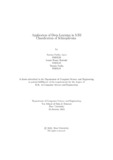| dc.contributor.advisor | Bin Ashraf, Faisal | |
| dc.contributor.advisor | Rahman, Md. Shahriar | |
| dc.contributor.author | Joyee, Ramisa Fariha | |
| dc.contributor.author | Rodoshi, Lamia Hasan | |
| dc.contributor.author | Nadia, Yasmin | |
| dc.date.accessioned | 2024-05-05T05:17:30Z | |
| dc.date.available | 2024-05-05T05:17:30Z | |
| dc.date.copyright | 2023 | |
| dc.date.issued | 2023-01-23 | |
| dc.identifier.other | ID: 19301250 | |
| dc.identifier.other | ID: 19301248 | |
| dc.identifier.other | ID: 19301241 | |
| dc.identifier.uri | http://hdl.handle.net/10361/22719 | |
| dc.description | This thesis is submitted in partial fulfillment of the requirements for the degree of Bachelor of Science in Computer Science and Engineering, 2023. | en_US |
| dc.description | Cataloged from PDF version of thesis. | |
| dc.description | Includes bibliographical references (pages 44-47). | |
| dc.description.abstract | In today’s world, when people are suffering from complex brain diseases, MRI has
been playing a very significant part in understanding brain functionalities and its
abnormalities. Deep learning has been recently used for the analysis of MRI, fMRI,
structural MRI etc. and through this, we have achieved better performance than
traditional computer-aided diagnosis for brain disorders. However, similar compo sition of brain diseases makes it hard to find out and differentiate the accuracy of
exact disease from the acquired neuroimaging data. Accordingly, in this paper, a
multi channel 2D CNN based architecture was implemented on COBRE dataset
1 which presents a significantly high accuracy over some models. Our modified
multichannel 2D CNN architecture achieves around 97% accuracy which improves
our classification performance. Furthermore, the paper discusses the boundaries of
existing studies, the DL methods and present future possible directions. | en_US |
| dc.description.statementofresponsibility | Ramisa Fariha Joyee | |
| dc.description.statementofresponsibility | Lamia Hasan Rodoshi | |
| dc.description.statementofresponsibility | Yasmin Nadia | |
| dc.format.extent | 47 pages | |
| dc.language.iso | en | en_US |
| dc.publisher | Brac University | en_US |
| dc.rights | Brac University theses are protected by copyright. They may be viewed from this source for any purpose, but reproduction or distribution in any format is prohibited without written permission. | |
| dc.subject | Schizophrenia | en_US |
| dc.subject | Deep learning (DL) | en_US |
| dc.subject | Neuro-image | en_US |
| dc.subject | MRI | en_US |
| dc.subject | Computer aided diagnosis | en_US |
| dc.subject | Neuro-psychiatric disease | en_US |
| dc.subject | DNN | en_US |
| dc.subject | CNN | en_US |
| dc.subject | SVM | en_US |
| dc.subject | RNN | en_US |
| dc.subject | COBRE | en_US |
| dc.subject | NUSDAST | en_US |
| dc.subject.lcsh | Deep Learning | |
| dc.title | Application of deep learning in MRI classification of Schizophrenia | en_US |
| dc.type | Thesis | en_US |
| dc.contributor.department | Department of Computer Science and Engineering, Brac University | |
| dc.description.degree | B.Sc. in Computer Science and Engineering | |

